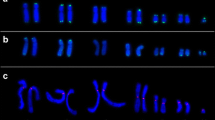Abstract
We examined the genetic make-up and plausible origins of the supernumerary (B) chromosomes of the Pacific giant salamander, Dicamptodon tenebrosus, from the Pacific Northwest of North America. These salamanders have variable numbers of B chromosomes, from 0 to 10 per individual. Salamanders from the most southerly and northerly regions of the species' range have lower average numbers of B chromosomes than salamanders in the middle of the range. To assess how the supernumerary chromosomes originated in D. tenebrosus, B chromosome DNA was isolated by microdissection and amplified by degenerate oligonucleotide-primed PCR. The B chromosome DNA hybridized similarly to genomic DNA from individuals of D. tenebrosus and the related species D. copei and D. ensatus, thus demonstrating that the supernumerary chromosomes were derived from the normal chromosome complement. Unique hybridization bands in both D. copei and D. tenebrosus suggest that the shared sequences have evolved independently.
Similar content being viewed by others
References
Altschul SF, Madden TL, Schäffer AA et al. (1997) Gapped BLAST and PSI-BLAST: a new generation of protein database search programs. Nucleic Acids Res 25: 3389-3402.
Amos A, Dover G (1981) The distribution of repetitive DNAs between regular and supernumerary chromosomes in species of Glossina (tsetse): a two-step process in the origin of supernumeraries. Chromosoma 81: 673-690.
Ausubel FM, Brent R, Kinston RE et al. (eds.) (1995) Current Protocols in Molecular Biology. New York: John Wiley & Sons, Inc.
Avise JC (1994) Molecular Markers, Natural History and Evolution. New York, Chapman & Hall, pp 69-72.
Batistoni R, Pesole G, Marracci S, Nardi I (1995) A tandemly repeated DNA family originated from SINE-related elements in the European plethodontid salamanders (Amphibia, Urodela). J Mol Evol 40: 608-615.
Beukeboom LW (1994) Bewildering Bs: an impression of the 1st B-chromosome conference. Heredity 73: 328-333.
Brutlag DL (1980) Molecular arrangement and evolution of heterochromatic DNA. Ann Rev Genet 14: 121-144.
Camacho JPM, Sharbel TF, Beukeboom LW (2000) B-chromosome evolution. Phil Trans R Soc Lond B 355: 163-178.
Castro J, De Lucchini S, Nardi I, Sánchez L, Martínez P (1997) Molecular analysis of a NOR site polymorphism in brown trout (Salmo trutta): organization of rDNA intergenic spacers. Genome 40: 916-922.
Covert SF (1998) Supernumerary chromosomes in filamentous fungi. Curr Genet 33: 311-319.
Dobson SL, Tanouye MA (1998) Interspecific movement of the paternal sex ratio chromosome. Heredity 81: 261-269.
Eickbush DG, Eickbush TH, Werren JH (1992) Molecular characterization of repetitive DNA sequences from a B chromosome. Chromosoma 101: 575-583.
Franks TK, Houben A, Leach CR, Timmins JN (1996) The molecular organization of a B chromosome tandem repeat sequence from Brachycome dichromosomatica. Chromosoma 105: 223-230.
Good DA (1989) Hybridization and cryptic species in Dicamptodon (Caudata: Dicamptodontidae). Evoluton 43: 728-744.
Green DM (1990) Muller's Ratchet and the evolution of supernumerary chromosomes. Genome 33: 818-824.
Green DM (1991) Supernumerary chromosomes in amphibians. In: Green DM, Sessions SK (eds) Amphibian Cytogenetics and Evolution. San Diego, California: Academic Press, Inc., pp 333-358.
Houben A, Kynast RG, Heim U, Hermann H, Jones RN, Forster JW (1996) Molecular cytogenetic characterization of the terminal heterochromatic segment of the B-chromosome of rye (Secale cereale). Chromosoma 105: 97-103.
Houben A, Leach CR, Verlin D, Rofe R, Timmis JN (1997) A repetitive DNA sequence common to the different B chromo-somes of the genus Brachycome. Chromosoma 106: 513-519.
John UP, Leach CR, Timmis JN (1991) A sequence specific to B chromosomes of Brachycome dichromosomatica. Genome 34: 739-744.
Jones RN (1995) Tansley review no. 85. B chromosomes in plants. New Phytol 131: 411-434.
Jones RN, Rees H (1982) B Chromosomes. New York: Academic Press.
Langdon T, Seago C, Jones RN et al. (2000) De novo evolution of satellite DNA on the rye B chromosome. Genetics 154: 869-884.
Leach CR, Donald TM, Franks TK, Spiniello SS, Hanrahan CF, Timmis JN (1995) Organization and origin of a B chromosome centromeric sequence from Brachycome dichromosomatica. Chromosoma 103: 708-714.
López-León MD, Neves N, Schwarzacher T, Heslop-Harrison JS (Pat), Hewitt GM, Camacho JPM (1994) Possible origins of a B chromosome deduced from its DNA composition using double FISH technique. Chromosome Res 2: 87-92.
McAllister BF, Werren JH (1997) Hybrid origin of a B chromosome (PSR) in the parasitic wasp Nasonia vitripennis. Chromosoma 106: 243-253.
McVean GT (1995) Fractious chromosomes: hybrid disruption and the origin of selfish genetic elements. Bioessays 17(7): 579-582.
Pich U, Houben AH, Fuchs J, Meister A, Schubert I (1994) Utility of DNA amplified by degenerate oligonucleotide-primed PCR (DOP-PCR) from the total genome and defined chromosomal regions of field bean. Mol Gen Genet 243: 173-177.
Potz H, Schubert V, Houben A, Schubert I, Weber WE (1996) Aneuploids as a key for new molecular cloning strategies: development of DNA markers by microdissection using Triticum aestivum-Aegilops markgrafii chromosome addition line B. Euphytica 89: 41-47.
Sapre AB, Deshpande DS (1987) Origin of B chromosomes in Coix L. through interspecific hybridization. J Hered 78: 191-196.
Schondelmaier J, Martin R, Johoor A et al. (1993) Microdissection and microcloning of the barley (Hordeum vulgare L.) chromosome 1HS. Theor Appl Genet 86: 629-636.
Sessions SK (1984) Cytogenetics and Evolution in Salamanders. PhD dissertation, University of California, Berkeley.
Sessions SK (1996) Chromosomes: molecular cytogenetics. In: Hillis DM, Moritz C, Mable BK (eds) Molecular Systematics, second edition. Sunderland, Massachusetts: Sinauer Associates, pp 121-168.
Singer M, Berg P (1991) Genes and Genomes. Mill Valley, CA: University Science Books.
Stephan W, Cho S (1994) Possible role of natural selection in the formation of tandem-repetitive noncoding DNA. Genetics 136: 333-341.
Telenius H, Carter NP, Bebb CE, Nordenskjöld M, Ponder BAJ, Tunnacliffe A (1992) Degenerate oligonucleotide-primed PCR: general amplification of target DNA by a single degenerate primer. Genomics 13: 718-725.
Vershinin AV, Alkhimova EG, Heslop-Harrison JS (1996) Molecular diversification of tandemly organized DNA sequences and heterochromatic chromosome regions in some Triticeae species. Chromosome Res 4: 517-525.
Author information
Authors and Affiliations
Rights and permissions
About this article
Cite this article
Brinkman, J.N., Sessions, S.K., Houben, A. et al. Structure and evolution of supernumerary chromosomes in the Pacific giant salamander, Dicamptodon tenebrosus . Chromosome Res 8, 477–485 (2000). https://doi.org/10.1023/A:1009215621509
Issue Date:
DOI: https://doi.org/10.1023/A:1009215621509




